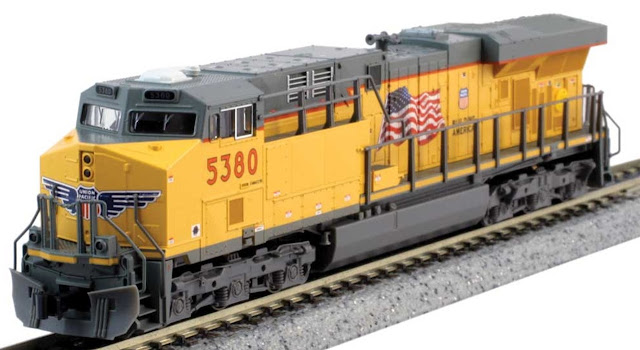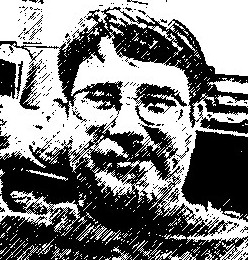In my last post I mentioned the possibility of putting sound in the modern Kato diesels. To that end, I did purchase a couple of Digitrax SDNX146K1E decoders, but they have keep-alive capacitors that just don't fit anywhere under the shells. The speakers are the oval type that will fit under the shell tucked under the rear light LED, they will go in without modifying the frame, but those darn caps just won't fit in anywhere.***
A second option is a sound decoder made by XL Systems Inc. I haven't linked them for the simple reason that they are crap. They used to make the sound decoders for MRC, and they were crap then, too. I put one (MRC 1961) in the Hudson I had repainted in Erie fantasy paint and ripped it back out again because I couldn't get the start speed set to move the loco at speed step 1; at speed step 1 the loco would chuff merrily while not moving at all. To date it's the only functional decoder I've ever thrown in the trash. But, the XL's are inexpensive, so I bit the bullet and ordered one for the CSX SD70M.
Yep. Still trash.
The good thing about them...well, three good things I guess...are they are inexpensive, they do work (in that they will make noise and make the locomotive move, mostly at the same time), and they are true drop-in decoders because the motor power clips are already installed (the Digitrax board requires you to remove the clips from the stock Kato DC light board and install them on the decoder board). Another nice thing is the speaker is installed on the board, so no frame modifications needed. It's nice and loud, too, being at the top of the locomotive and not underneath in the fuel tank. If all you want is an operational decoder that makes noise and you don't care about speed matching (or making the loco move at speed step 1) the XL may just fit the bill for you. However, if speed matching and loco movement at speed step 1 is important to you, the XL won't be a good choice.
The problem with these (and the MRC's that preceded them) is they are nigh unto impossible to program the speed effectively with a standard speed table. They don't have a mid range CV (6), and the high speed CV (5) is only adjustable from 0-63 instead of the full 0-255. As with the Hudson, I have never been able to get them to move at speed step 1, either, although (again, as with the Hudson's chuff) the diesel sound notches up at that setting. Unlike with the steam loco chuff, the diesel loco moves before the throttle notches again, so there is that at least.
They do have a full speed table, but that is a pain in the arse to program so I haven't ever tried doing it that way**. Who knows, that might work fine, but (yeah, not so much, see footnote) it was enough of an irritation that I pulled the XL back out of the Kato and replaced it with a non-sound TCS that programs easily with a standard speed table (CV's 2, 5 and 6 for start, full and mid speeds respectively). All of my modern locos will run the exact same speeds now, and only the NS loco has sound (but that's something I'm fine with).
I do have three XL 0001955 sound decoders for Atlas GP7's that I believe can be modified for my triple set of Bachmann GP7's. The Bachmann GP7s, like so many other Bachmann non-sound DCC equipped locos, have crippled Lenz decoders that have a non-programmable speed table (their sound decoders are downgraded Soundtraxx units). IIRC you can program the start speed (CV2) but not the mid or top speeds. That means no speed matching, but they do run close enough to each other that they can be run as a single unit. However, they are enough different that I don't dare use one as a DPU.
So if I ever want to run them with other units, or use one as a DPU, the choice is semi-programmable XL crap that I might be able to program with the full speed table using CV's 67-94, or maybe - just maybe - the more expensive but easily programmable silent drop in decoders from Digitrax, TCS or NCE with the same installation caveats as the XL. I have seen an installation of the MRC 1955 sound decoder (made by XL, therefore identical to the XL 0001955), so I know that one will work, and I assume the others would as well following the same installation tricks. The sound is a bonus, but they have to be wired to the motor and the contact springs have to be removed from the Bachmann/Lenz decoders and soldered onto the XL's (and I assume the Digitrax, TCS and NCE drop-ins) for installation. That's why I haven't put them in yet.
UPDATE: I just pulled the XL decoders out of the bag and pulled the top off of a Bachmann GP7. They won't fit. I'll either have to hard-wire a decoder or live with what I have.
And speaking of modern locos...I have acquired yet another one, this one in BNSF livery like the one above (except mine is number 5953). It is a Kato ES44AC and it, too, has been equipped with a TCS non-noise decoder. So now I have a Kato Norfolk Southern SD70ACE with Digitrax sound decoder, a Fox Valley Models Erie heritage SD70ACE with a six pin something (TCS, I think) decoder, a Kato CSX SD70M with TCS decoder, a Fox Valley Models PRR heritage ES44 with 6 pin Digitrax decoder, and a Kato BNSF ES44AC with TCS decoder.
All I need now is a modern loco in UP livery to round out the collection.*
*EDIT: It's on order, I couldn't resist. I'm trying out an NCE decoder on this one. UPDATE: It has arrived, and the NCE decoders work fine with the special NCE kick programming to get them to move at speed step 1. I also ordered an ES44DC in CSX paint because the flat-radiator SD70M just didn't look right to me, but for some reason I didn't order a decoder for it at the same time like I usually do. I'll have to get one when it gets here.
**I tried programming an XL with the 28 step speed table. It's even more frustrating than attempting to do so with a three step table.
***The answer to this problem was found in this video. Long story short, replace the cap with a surface mount one with longer wires. It works, and the oval speaker fits fine under the shell, but it doesn't make a lot of prime mover noise. That may be a good thing, though.














